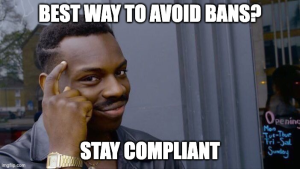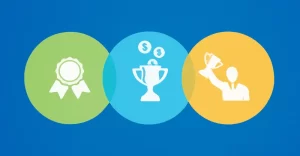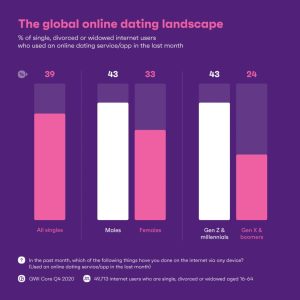Affiliate Marketing Traffic Sources: The Definitive Beginners Guide
If you have recently decided to get into affiliate marketing, you will soon have to determine which affiliate marketing traffic sources to utilize. Your traffic source is where you find and direct online users to the affiliate offers you promote through networks like MaxBounty.
Understanding and choosing which traffic sources to use to promote CPA (cost-per-action) affiliate offers can be overwhelming. It does not help that there are more ways than ever for affiliates to acquire traffic.
This guide will simplify the process while helping you choose the one that is right for you.
When we say one, we do mean one.
If your goal is to start promoting your first offer as an affiliate at Bulkcpa in the near future, we highly suggest that you choose just one of the affiliate marketing traffic sources we discuss in this post.
Focusing on only one will provide you with a greater learning opportunity. Even if you do not find success immediately, you will greatly expand your knowledge on that particular traffic type. Building that initial foundation of knowledge is so important as a beginner affiliate.
If you try to manage multiple forms of traffic at once, you will spread yourself too thin and hinder your ability to gain valuable insight.
Traffic Types
Although there are hundreds of affiliate marketing traffic sources available to you, most can be classified into less than a dozen types.
Let’s do a quick rundown of each type we allow at Bulkcpa.
1. Display
Your standard, visual-based ad located on most websites.
2. PPV/Contextual
Pop-ups or pop-unders usually enabled through toolbars. Google Adsense is also considered contextual traffic.
3. Search
Search result ads purchased through platforms like Google Ads or Microsoft (formerly Bing) Ads.
4. Native
Ads that mimic the media format in which they appear. Commonly seen in “Recommended Content” widgets found on various websites.
5. Social
Either organic traffic that comes through social media pages with large followings or traffic from paid ads or sponsored content (Facebook ads, Instagram ads, Youtube ads, etc.).
6. Mobile
Any user traffic that is directed through a mobile device. These can take the form of some of the other types mentioned on this list such as display, pop-unders, and push notifications.
7. E-mail
Promoting offers through email blasts to a list of recipients.
8. Incentive
Traffic that comes from incentivization. An example would be gifting digital rewards or currency to a user for completing a task.
We will go into greater detail on each type and its individual sources a little later. Before that, let’s talk about some factors that you should take into account when making your decision.
9. Push Notifications
Promoting campaigns through mobile or desktop notifications that users opt-in to and that are sent directly to their devices.
10. Organic Traffic
Traffic that you do not pay for that comes through organic search results or other sources.
Key Decision Factors
Your experience level
The level of experience you have at affiliate marketing should play a significant role in choosing offers and traffic sources.
Although the goal of any affiliate is to make money, complete beginners should have some other priorities as well.
If you are literally promoting your first campaign ever, it is crucial that focus on achieving some type of results. By results we mean clicks and/or conversions.
Even if your campaign is barely profitable, by directing traffic to your campaign you’ll gain:
An understanding of how clicks and/or conversions are tracked in Bulkcpa’s Affiliate Dashboard
Insight and data that will help you learn more about your current strategy
Motivation to improve/keep trying
You can accomplish this by choosing offers that have a greater chance of converting. In return, you’ll make less for each lead you convert than you would with an offer that tends to convert less frequently.
These types of offers are often part of specific verticals that convert best with certain traffic sources.
You can learn more about selecting offers as a beginner by reading our post: 6 Tips for Choosing Affiliate Marketing Campaigns as a Beginner
It is important that you take all of the above into account if you are choosing a traffic source for the first time.
Your budget
Unless you are getting into affiliate marketing because you already have a website, blog, or social media page that you want to monetize, you will likely need to pay for your traffic.
Traffic sources vary greatly in reach, audience, targeting options, and quality. Therefore, they also vary greatly in cost.
Determining how much you are willing to spend will eliminate traffic sources that require larger budgets.
We recommend that beginners start with a small budget. Even if you can afford to spend more initially, it will likely take some time to find a winning campaign strategy.
Once you become more comfortable promoting offers and determining what works (and what doesn’t), you can start increasing your budget and scaling your campaigns.
Pre-existing skills
Are you already a great writer, coder, designer, or social media expert? If so, those are valuable skills that can benefit your affiliate marketing career. This is especially true if the skill pairs well with your traffic source.
For instance, you can create your own custom landing pages if you have some experience with Photoshop or other design programs. This will make it easier for you to test different sales angles for each campaign.
Custom landing pages operate as a bridge between your traffic source/ad and the offer you’re promoting. Some traffic types, like social, work best with a custom landing page, where with others it’s not necessary.
Vertical and niche
Every offer at Bulkcpa has a different set of permitted traffic sources. Therefore, the types of offers you decide to promote or the niche they’re in can influence your traffic source preferences.
You may already have a vertical or niche in mind that you’re passionate about that you want to monetize with affiliate marketing. If so, that’s going to narrow down your traffic source choices, as some offers don’t work well with certain traffic.
Talking with your Bulkcpa Affiliate Manager or reading our Guide on Vertical and Niches are both great ways to learn more about vertical and traffic source compatibility, as is continuing to read this guide.
Now we have those key decision factors out of the way, lets look at each specific traffic type in more detail.
The Main Affiliate Marketing Traffic Types
1. Display Traffic

Display traffic is what comes to mind for most people when they think of online advertising. Although display traffic can encompass other traffic types as well, it most commonly refers to those square, image-based ads you see throughout most websites.
Affiliates who own a blog or website that garners substantial user traffic often monetize their site by populating it with banner or in-text display ads.
These ads can be of various sizes so that that they will work aesthetically on multiple areas around any site. Some of the most common banner sizes are 300×250, 728×90, and 160×600.
Shorter, wider banners are usually found at the top, bottom, or in-between content, while taller and narrower banners populate side panels.
If you are a Bulkcpa affiliate, you will notice that most of our offers already feature pre-made banners that you can use for promotion. These are provided by the advertiser of the offer.
Displays ads are most effective when the content of the website/blog and the products/services being advertised are relevant. Don’t expect to generate many leads if you are advertising a skincare product on a fantasy football site. There should be some symmetry between the two audiences.
You can also still utilize display traffic even if you do not have your own website or blog through media-buying.
Media buying works by utilizing a display network to place your ad on a website that already has significant traffic. You’ll then pay for that space on either a CPM (cost-per-1000-impressions) or CPC (cost-per-click) model.
Here’s some of the most popular display traffic networks among our own affiliates
SiteScout
Propeller Ads
Clicksor
What offers convert best:
Offers that payout on a completed sale, health and beauty campaigns, and niche offers that directly relate to the website/blog.
2. PPV/Contextual Traffic

Pay-per-view, cost-per-view, or contextual traffic primarily consists of pop-ups (or pop-unders). These are often delivered to users through a toolbar installation on their browsers.
Here’s how the whole process works:
A PPV network present users with the option of downloading a toolbar to their browser in exchange for digital rewards (games, special content, browser features, etc.).
The user will then install the incentivized toolbars to their computer.
Once the toolbar is installed, ads will be displayed to them in the form of pop-ups that advertise the offer that you’re promoting.
When the user clicks on the ad, they’re directed to the offer’s landing page or a pre-sell landing page that you’ve created.
URL or keyword targeting that you bid on against other advertisers will determine the location of your PPV ads.
URL targeting
Your pop-up will appear when a user goes to a specific URL/website. (eg. ESPN.com)
Keyword targeting
Your pop-up will appear when a user searches for a specific keyword. (eg. football jerseys)
Here are the PPV networks that are most commonly used by our affiliates:
50onRed/RTX Platform (Minimum Deposit: $500)
Propel Media (Minimum Deposit: $1000)
Direct CPV (Minimum Deposit: $100)
You can learn more about PPV traffic by reading our PPV Campaign Traffic Guide for Affiliate Marketers.
What offers convert best:
You need to present value to the user quickly if you’re promoting with PPV. Therefore, offers with short forms as well as travel and sweepstakes campaigns do well with this traffic type.
3. Search Traffic

Whenever you Google something, the search results are often separated into two sections – ads and organic search results. The handful of sites in these results that feature an ‘Ad’ label beside them are paying for that position – this is a form of search traffic.
The Google Ads platform allows for advertisers to pay for their sites to be listed at the top of search results for specific keywords. This is accomplished by bidding on keywords through a PPC (pay-per-click) model, meaning you’ll pay Google a specific amount every time a user clicks on your ad.
When you use Google Ads to promote an offer, you’re ensuring you’re putting the product or service you’re promoting in front of the people who are searching for it or something closely related.
Bing also has its own search traffic platform, Microsoft Ads, that’s works in a similar fashion to Google Ads.
Obviously, Bing isn’t going to offer the same level of reach as Google, because there’s less people using Bing as their primary search engine. However, it’s more affordable than Google Ads and has less restrictions, making it more affiliate friendly by allowing a broader selection of offers to be promoted on the platform.
What offers convert best:
Search traffic can work for a wide array of niches, but offers in diet and financial/loan verticals perform especially well.
4. Native Ad Traffic

Native ads are an affiliate marketing traffic source that continue to grow in popularity.
They’re also extremely effective at being a rare, non-disruptive form of advertising.
This means that users are more likely to engage with native ads over traditional display ads because they’re less likely to feel as if their online experience is being interrupted by an ad.
It’s the online equivalent of using product placement in TV shows instead of commercials.
You know when you’re completely into your favorite TV show when suddenly a commercial break pulls you out of the immersion? That’s basically what a banner ad does to someone reading an article on a website. Native ads are a sly way of resolving that issue.
You’ve likely noticed “Recommended Articles” or “Sponsored Content” headings while you’re on a website. Those are native ads.
To use native ads as a traffic source, you’ll have to sign-up to a native ad network to have your ads placed on various websites. Those ads then direct to the landing or sales page of the offer you’re promoting.
We currently have a partnership with native ad network Taboola. If you’re a Bulkcpa affiliate, you will receive a $100 bonus after spending $100 worth of ad budget in their platform.
Keep in mind that using native ads will require you to compete with other affiliates/advertisers for site placement, and the larger the site/traffic, the more you can expect to have to bid.
If you’d like to gain additional insight into native ads, read our Native Ad Tips post.
What offers convert best:
Native ads work best with offers that can be paired with powerful imagery and enticing copy to trigger an emotional response. Eg. “Moms are obsessed with this new anti-aging cream!” “This 2019 gadget is rapidly changing lives!”)
Finance, weight loss, and tech products work best with this approach.
5. Social Media Traffic

Social media platforms have massive user bases and therefore massive audiences. That’s why many affiliates utilize them as their go-to traffic source.
In addition to large audiences and the ability for anyone to purchase advertising, social media platforms offer advertisers expansive targeting options. This allows you to easily hone in on the people who are most likely to be attracted to what it is you’re promoting. Advanced targeting ensures that you’re not wasting time and money advertising something to an audience who wants nothing to do with that niche.
The most common social media platforms that affiliates use to promote offers are:
Facebook
Instagram
YouTube
LinkedIn
Twitter
Pinterest
Snapchat
TikTok
Most of these platforms offer a multitude of ad targeting options for you to customize when you’re creating and launching an ad campaign.
For instance, Facebook ads allow you to target users by:
Geographical location
Gender
Age range
Interests
You can also decide whether to pay for clicks or impressions, which is something that will take some time and testing to determine the best approach.
In addition to purchasing advertising, you can create and grow fan pages that can be used as your own marketing channel for promoting offers.
Perhaps as a hobby you’ve already built up a large follower base on an Instagram account or Facebook Page. You can monetize those pages by integrating links to Bulkcpa offers with regularly-posted content. There’s many Bulkcpa affiliates making money with this strategy, just remember to only promote offers that are going to catch the interest of the followers on your pages.
If you operate a pet Instagram account where your followed by thousands of people who are waiting anxiously for you to post pics of adorable dogs, you should populate your bio or story with links to a pet-related offer rather than trying to promote car loans.
What offers convert best:
Recognizable and trusted brands and/or e-commerce, clothing, dating, games and tech gadgets.
6. Mobile Traffic

Mobile traffic is comprised of multiple traffic sources that are being delivered to users on mobile devices. This includes many of the traffic sources we have listed above as well others like push notifications which we’ll get too later.
The continual evolution of smartphone technology and the increase in time we spend staring at our pocket-sized screens has transformed mobile into one of the most lucrative traffic sources.
The percentage of users who spend their time online on a mobile device rather than at a computer is increasing each year, and the affiliate marketing industry is responding with more mobile offers and traffic sources.
There are numerous mobile traffic sources that use the same traffic types we discussed above, the only difference is the traffic is shifted off of desktop and onto mobile. For example, you can sign up to a mobile traffic platform and advertise the offer you’re promoting through display/banner ads or pop-up/under ads.
Check out AirPush.com if you’re looking for a mobile ad network that offers some great targeting options.
What offers convert best:
Apps and mobile games.
7. E-mail Traffic

E-mail traffic involves collecting e-mail addresses to create your own audience for the purpose of promoting offers.
If you already own a website or a blog, the process of capturing e-mails can be as simple as prompting your visitors to sign-up to your newsletter. Once your list has grown to a substantial size, you can send them tailor-made e-mails that feature offers relating to the niche that brought them to your site in the first place.
You can still utilize e-mail as a traffic source even if you don’t have an established website of your own. This can be accomplished by using a squeeze page (a landing page that asks for a user’s e-mail) when promoting with other traffic types, or purchasing e-mail lists from 3rd party traffic sources. However, The quality of the traffic you’ll obtain from these lists can be unpredictable.
What offers convert best:
Loan, debt relief, e-commerce, education, and biz opp offers.
8. Incentive Traffic

Incentive traffic is when you offer users something in return for generating a conversion on the campaign you’re promoting. You’re providing them an incentive for completing an action, hence the name.
The incentive itself usually come in the form of digital rewards, points, coupons, or virtual currency. Sometimes the incentive can also be the ability to access additional content such as an e-book or other downloadable files (content-locking).
The number of advertisers and offers that allow incentive traffic is fewer than other traffic sources, which means it’s not an ideal traffic source for many beginner-level affiliates.
What offers convert best:
Survey and sweepstakes offers tend to work best with incentive traffic.
9. Push Notifications Traffic

Push notifications are the newest traffic source on this list but it’s quickly becoming one of the most popular.
They’re those little messages you receive on your mobile device as well as your personal computer. In order to get those messages, users have to opt-in to them on the websites they visit on their phone or computer.
Push notifications are a unique traffic source in that every person you’re targeting with has already opted-in to see the content you’re promoting. This means you can expect an increase in engagement with push notifications over other traffic sources. Your ads aren’t being “cold” delivered to users.
To use ‘push’ traffic, you have to sign up to a traffic network that will then allow you to get your campaign in front of those people who have opted-in.
Another great thing about this traffic type is that it’s relatively inexpensive, and most traffic networks allow you to choose between both CPC and CPM pricing models.
Some of the ones our own affiliates have found success with include:
Propeller Ads
AdCash
RichAds
What offers convert best:
A versatile traffic source that works well with a variety of verticals such as sweepstakes, dating, weight loss, and coupon and cashback offers.
10. Organic Traffic
Organic traffic is simultaneously one of the most effective traffic sources at generating conversions while also being the most difficult to achieve. It’s the only traffic type with no direct cost as well.
We briefly touched on a couple organic traffic sources earlier in the guide in the display and social media sections.
The primary way to acquire organic traffic is through content writing on a website or blog. You then use search engine optimization (SEO) strategies to drive people to your site organically through search engines. Getting your links placed on other sites around the web can also help drive organic traffic.
Once users make it to your site, they will click on affiliate marketing links or display banners that you’ve placed that direct to an offer.
You can also utilize organically-grown social media pages on platforms like Facebook and YouTube to acquire organic traffic.
All of the above will take a lot of time and hard work to achieve. However, it can be the single most effective traffic source in affiliate marketing because the users are coming to your campaigns completely on their own will. That means more engagement and more conversions.
What offers convert best:
Nearly any type of offer can work well with organic traffic as long as it’s relevant to your site and audience.
Conclusion
If you’re a beginner-level affiliate, it’s important that you initially promote campaigns using just a single traffic source. This will allow you to remain focused while getting the opportunity to gain knowledge and not stretch your budget too thin.
We recommend that you combine the information you’ve learned from this guide with any additional research to help you choose the best traffic type for you.
You can spend hours, days, and weeks educating yourself on ways to acquire traffic, what networks to work with, and what offers are available. Ultimately, what you’ll learn from that research will never compare to what you will learn when you’re actively promoting offers.
Make some decisions and go for it.